San Francisco; The City by the Bay

Things to do in San Francisco, California
San Francisco is a breathtaking Northern California city that offers an abundance of history, stunning scenery, fresh air and delicious cuisine. Once you visit San Francisco, you’ll understand how there simply isn’t anywhere else like it on this planet. San Francisco is a unique city that should be on the top of your travel bucket list.
The earliest evidence that humans lived in San Francisco goes back to 3000 BC. The Yelamu group of the Ohlone people lived in small villages in San Francisco, when Don Gaspar de Portolá and the rest of his Spanish exploration party arrived to the area on November 2, 1769. Don Gaspar de Portolá and his party were the first group of Europeans to visit San Francisco. In 1776, the Spanish created the Presidio of San Francisco. Mission San Francisco de Asís (Mission Dolores), was later created by the Spanish explorer, Juan Bautista de Anza. San Francisco received independence from Spain in 1821, and became part of Mexico. Mexico eventually got rid of the mission system and the lands became private. In 1846, Commodore John D. Sloat claimed the state of California for the United States, during the Mexican-American War. 2 days later John B. Montgomery arrived to the area to claim Yerba Buena. Yerba Buena was renamed San Francisco on January 30, 1847. At the end of the war, Mexico surrendered San Francisco to the United States.

Mission San Francisco de Asís (Mission Dolores) Photo Courtesy Wikipedia
San Francisco saw a boom of people looking to make their fortune from the California Gold Rush. They were given the nickname “forty-niners”, as the year was 1849. Prospectors made San Francisco their new home and boosted the population from 1,000 in 1848 to 25,000 by December 1849. California was granted statehood in 1850. Soon after, San Francisco saw a higher rise in entrepreneurs trying to capitalize on the Gold Rush.

Port of San Francisco in 1851 Photo Courtesy Wikipedia
Many companies started to take shape in San Francisco during The California Gold Rush, 2 of which included Wells Fargo in 1852 and The Bank of California in 1864. The Port of San Francisco and the newly completed Pacific Railroad assisted the Bay Area in becoming a great area for trade. Cable Cars started transporting citizens of San Francisco up Clay Street in 1873, Victorian houses began to pop up throughout the city and civic leaders started campaigning for park space, which resulted in the organization and planning of Golden Gate Park. By 1890, San Francisco became the eighth-largest city in the United States when the population reached 300,000.
On April 18, 1906, a large earthquake struck San Francisco at 5:12 am. The earthquake forced buildings to collapse, which resulted in severed gas lines creating fires that spread throughout the city and continued to burn for a few days after. The earthquake turned more than three-quarters of San Francisco into ruin and more than half of the city’s population (400,000) was left homeless. San Francisco immediately started to rebuild and recuperate, due to the help of loans given out by Amadeo Giannini’s Bank of Italy. Today Amadeo Giannini’s Bank of Italy is found all around the world, although you might know it by a different name; Bank of America.

“Not in history has a modern imperial city been so completely destroyed. San Francisco is gone.” –Jack London after the 1906 earthquake and fire. Photo courtesy Wikipedia
San Francisco eventually became known as a financial capital. During the 1929 Stock Market Crash, none of the San Francisco based banks failed. Along with seeing a start up of big banks, San Francisco has also been the epicenter of two booms, with the .com boom in the late 1990s and again in the 2000s with the social media boom. Today San Francisco is a wonderful and beautiful place to visit with lots of well-known landmarks throughout the city.
Downtown San Francisco, as seen from Twin Peaks Photo Courtesy Wikipedia
Alcatraz Island
Juan Manuel de Ayala, a man who made a map of the San Francisco Bay, was the first Spaniard to discover Alcatraz Island in 1775. Ayala identified three islands and named one of them “The Island of the Gannets,” which translates to “The Island of the Pelicans.” The Spanish began to occupy the island and built several small buildings and structures on it. Mexican Governor Pio Pico eventually gave the land of Alcatraz to Julian Workman in June 1846. Later in 1846, the island was sold again to John C. Fremont for $5,000, who was a “champion of Manifest Destiny and leader of The Bear Flag Republic.” In 1850, U.S. President Millard Fillmore order Alcatraz Island to become a United States military reservation. Fremont expected to be compensated by the U.S. government, but he never received any sort of payment. The U.S. government made the sale invalid and then canceled the payment that was suppose to go to Fremont. Fremont and his heirs sued the U.S. government and kept their legal battle afloat well into the 1890s, but never received any sort of payment.
Alcatraz started being used as a military prison in the early 1860s, for soldiers accused of crimes. By 1861, Alcatraz held a lot of Civil War prisoners of war. The population of Alcatraz saw a heavy increase in 1898, due to the Spanish-American War. Civilian prisoners began to occupy Alcatraz after the 1906 San Francisco earthquake.
Alcatraz was obtained by the United States Department of Justice in October of 1933 and was turned into a federal prison in August 1934. On August 11, 1934 at 9:40 am, Alcatraz received the first group of 137 prisoners. Alcatraz went on to be a fully functional prison for the next 29 years and housed some of the most notorious criminals in American history. The list includes Al Capone, Robert Franklin Stroud (the “Birdman of Alcatraz”), George “Machine Gun” Kelly, Bumpy Johnson, Rafael Cancel Miranda (a member of the Puerto Rican Nationalist Party who attacked the United States Capitol Building in 1954), Mickey Cohen, and Alvin “Creepy” Karpis.
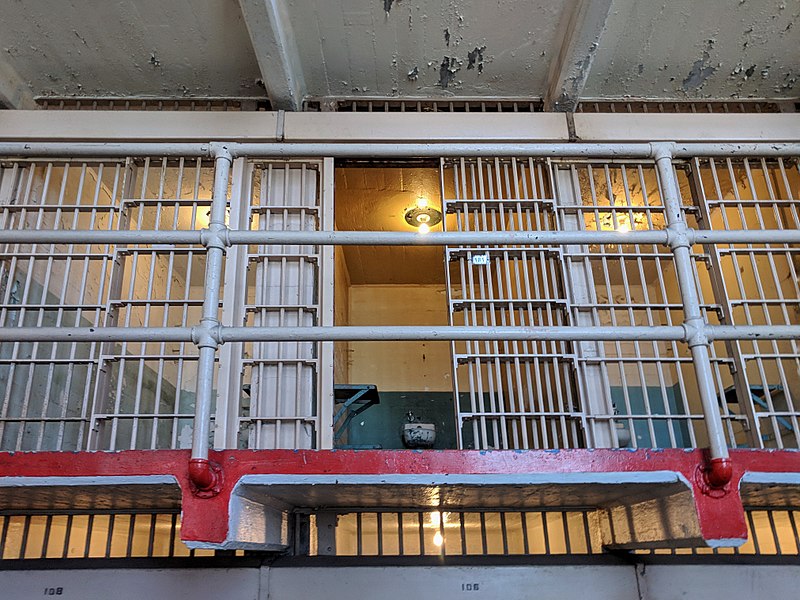
Cell 181 in Alcatraz where Al Capone was imprisoned Photo Courtesy Wikipedia
During the 29 years that Alcatraz was in operation, no one successfully escaped the prison, but 36 prisoners made 14 escape attempts. 23 men were caught alive, six were shot and killed in the middle of their escape, two drowned and five men are listed as “missing and presumed drowned.” If a prisoner did successfully escape and started to swim to shore, he was usually caught or drowned before reaching land. John Paul Scott successfully escaped and swam to shore, but was eventually found unconscious by police. Today there is an event called the “Escape from Alcatraz Triathlon” where participants swim 1.5 miles from the prison to the shore.
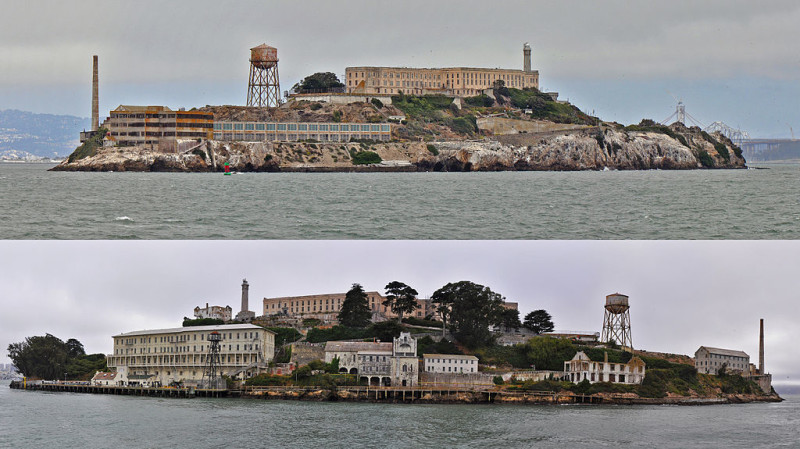
Photo Courtesy Wikipedia
Alcatraz was closed as a penitentiary in 1963 because of 3 reasons. It was costing the prison too much to house prisoners (almost $10 per prisoner per day), the saturation of the salt water had eroded the building and 3 people ended up escaping in 1962.

Alcatraz Island view from the west Photo Courtesy Wikipedia
Today Alcatraz Island is the #1 attraction to visit in San Francisco, according to TripAdvisor. Alcatraz Island offers a number of tours including a Day Tour, Night Tour, Behind the Scenes Tour and an Alcatraz and Angel Island Tour. Each tour provides each visitor with a head set that gives a narration of “Doing Time: The Alcatraz Cellhouse Audio Tour.” Alcatraz is a great destination to visit with the family that provides a very entertaining learning experience.
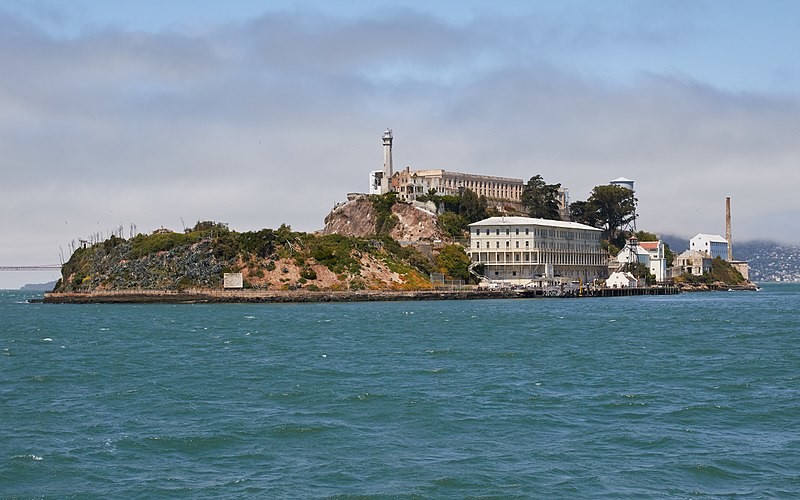
Photo Courtesy Wikipedia
Golden Gate Bridge
The Golden Gate Bridge is a suspension bridge that spans the Golden Gate and connects San Francisco Bay and the Pacific Ocean. The Golden Gate Bridge is one of the most recognized symbols of San Francisco and the United States. An engineer, by the name Joseph Strauss, designed The Golden Gate Bridge in 1917. The Golden Gate Bridge has been named one of the Wonders of the Modern World by the American Society of Civil Engineers.

Photo Courtesy Pixabay
The main walkway of the Golden Gate Bridge is open to pedestrians and bicyclists during weekdays from 5:00 am to 3:30 pm and then only to pedestrians for the remaining daylight hours. There is a visitor center and gift shop called the “Golden Gate Bridge Welcome Center” and is located on the San Francisco side of the bridge. The Golden Gate Bridge Welcome Center opened in 2012 just before the 75th anniversary celebration of the Golden Gate Bridge. Walking across the Golden Gate Bridge is a must when visiting San Francisco. The Golden Gate Bridge is also the #2 activity to do and sight to see according to TripAdvisor. The Frommer’s Travel Guide described the Golden Gate Bridge as “possibly the most beautiful, certainly the most photographed, bridge in the world.” The Golden Gate Bridge is an incredible sight to see and a one of the most well known landmarks in the world.
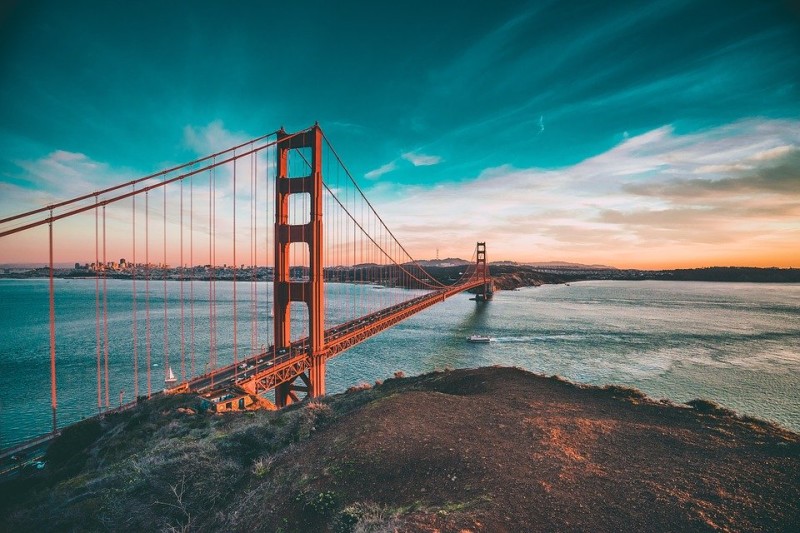
Photo Courtesy Pixabay
Golden Gate Park
Golden Gate Park is a large urban park open to the public in San Francisco. Golden Gate Park was configured as a rectangle and is a similar shape to Central Park in New York City, although Golden Gate Park is 20 percent larger. Golden Gate Park is the “third most-visited city park in the United States after Central Park and The Lincoln Memorial.” Golden Gate Park has plenty of areas for different activities for visitors to enjoy including the Main Concourse Area, “a sunken, oval-shaped open-air plaza,” the De Young Museum, named after M.H. de Young, (who co-founded the San Francisco Chronicle and who was also the director of the Associated Press), The Academy of Sciences, the National AIDS Memorial Grove, a Japanese Tea Garden, The Conservatory of Flowers, Shakespeare Garden, and even a Carousel. You can even see a small herd of Bison Paddock who roam the park.

The Japanese Tea Garden, opened in 1984 Photo Courtesy Wikipedia
Since 2008, Golden Gate Park has hosted Outside Lands Music and Arts Festival, which is a 3-day festival produced by Another Planet Entertainment. Many well known bands and musical artists have performed at Outside Lands including Tom Petty and the Heartbreakers, Radiohead, CAKE, M. Ward, She and Him, Jack Johnson, Pearl Jam, Tom Jones, The Avett Brothers, MGMT, The Decemberists, The Flaming Lips, Foo Fighters, Metallica, Stevie Wonder, Paul McCartney, Red Hot Chili Peppers, Vampire Weekend, Hall and Oates, Matt and Kim, Kanye West, The Killers, Elton John, The Who, Janet Jackson, the list goes on and on. Golden Gate Park has an abundance of fun activities, whether you want to go to a 3-day musical festival, read a book under the trees, have a picnic or take a walk.
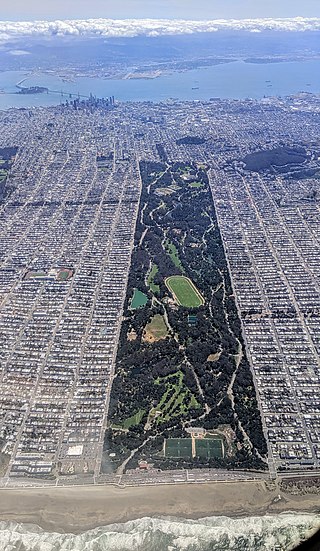
Aerial View of Golden Gate Park Photo Courtesy Wikipedia
Walt Disney Family Museum
The Walt Disney Family Museum is a museum dedicated to the life and legacy of Walt Disney. The museum is located in The Presidio of San Francisco, which is a part of the Golden Gate National Recreation Area in San Francisco. The Walt Disney Family Museum is a non-profit organization and was originally part of The Walt Disney Family Foundation, a non-profit created by Walt Disney’s heirs including his daughter, Diane Disney Miller, who is also the founder of the museum.
The Walt Disney Family Museum’s main building showcases technology, artifacts and historical materials that help bring Walt Disney’s accomplishments to life. The museum also has “interactive galleries with Walt Disney’s early drawings and animations, movies, music, listening stations, and a 12-foot diameter model of Disneyland.”
The lobby at The Walt Disney Family Museum has a display of 248 different awards that Walt Disney won throughout his career which include the Presidential Medal of Freedom and some of Disney’s Academy Awards. The museum also has a “Fantasia-inspired-state-of-the-art digital theatre”, which screens Disney films daily. There are also ten galleries including Walt Disney’s ancestral history. The Walt Disney Family Museum is a wondrous museum that offers something for all who love Disney.
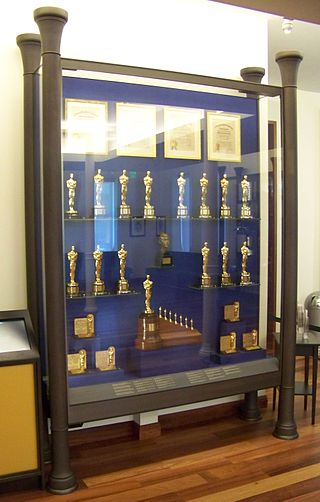
Award Display Photo Courtesy Wikipedia
2640 Steiner Street-The House From Mrs. Doubtfire
During your stroll through San Francisco, you may want to check out 2640 Steiner Street, which might be better known as the house from the 1993 Robin Williams film, Mrs. Doubtfire. While you cannot enter the home (someone lives inside), the outside of the house is still a cool sight to see and take a picture in front of. The house is located in scenic Pacific Heights, which is a neighborhood well know for its beautiful San Francisco homes.
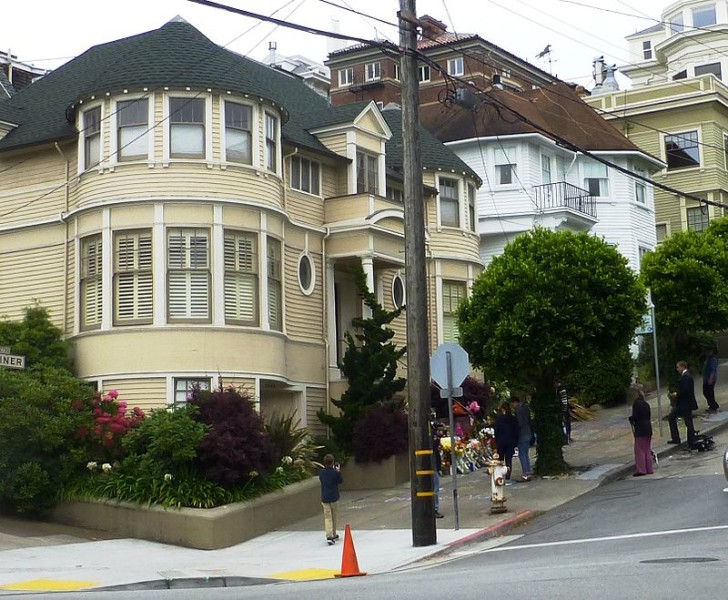
The exterior of 2640 Steiner Street in August 2014, taken just after the death of Robin Williams Photo Courtesy Wikipedia
Fisherman’s Wharf
Fisherman’s Wharf in San Francisco got its name because of the Italian immigrant fishermen that moved to the bay area in the mid 1800s to take advantage of the gold rush. One of the fishermen that moved to San Francisco was Achille Paladini, who became known as the “Fish King,” due to his “success of wholesaling local fish.” Most of the Italian immigrant fishermen lived in the North Beach area, close to the Wharf, and fished for local delicacies and Dungeness crab. Even though San Francisco became more of a tourist city in the 1970s and 1980s, the city is still home to many active fishermen.
Fisherman’s Wharf has become well known due to its location on Pier 39 and by being surrounded by the Cannery Shopping Center, Ghirardelli Square, a Ripley’s Believe it or Not museum, the Musée Mécanique, Wax Museum at Fisherman’s Wharf, and the San Francisco Maritime National Historical Park.

Photo Courtesy Wikipedia
Fisherman’s Wharf is a great place to go if you are looking for fresh seafood in San Francisco. Some of the seafood restaurants at Fisherman’s Wharf include; Fisherman’s Grotto, Pompei’s Grotto and Alioto’s, which all go back for three generations of the same family ownership. Other attractions you can visit at Fisherman’s Wharf include the USS Pampanito, a decommissioned World War II era submarine, and the Balclutha, which is a 19th century cargo ship. Fisherman’s Wharf hosts many big events including a fireworks show on the Fourth of July.
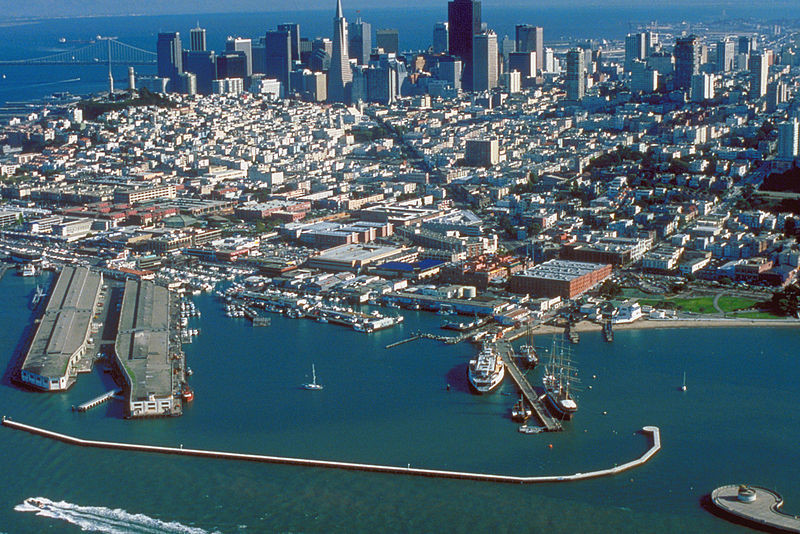
Aerial view of San Francisco, looking south, with Fisherman’s Wharf just left of center, directly above a lone sailboat Photo Courtesy Wikipedia
Squat & Gobble
Squat & Gobble offers a profound experience for anyone who is a “foodie” at heart. Squat & Gobble was originally known as a “crepery” at 237 Fillmore Street, but today is constantly revamping their menu items to serve a wide range of fresh and delicious meal selections. Squat & Gobble prides itself in being a “family-style restaurant with big portions, great food and an entirely welcoming atmosphere.” To frequent visitors, Squat & Gobble is known as THE breakfast location for locals and visitors. On a more personal note, I have an aunt who refuses to eat anywhere else in San Francisco, because she’s convinced no restaurant in the bay will win her over like Squat & Gobble has.
Squat & Gobble’s menu is filled to the brim with all sorts of goodies including Savory Crepes such as the Hangover (All Natural Ground Angus Chuck, American Cheese, Onions & Bacon Bits), Salmon Crepe (Sautéed Salmon, Swiss Cheese, Onions, Artichoke Hearts, Mushrooms, Sun-dried Tomatoes & Dill Aioli), Italian (Italian Sausage, Onions, Mushrooms, Spinach, Tomatoes, Scrambled Egg and Mozzarella Cheese. Topped with Pesto Sauce), and the Philly Streak Crepe (Grilled Angus Beef, Melted American Cheese, Mushrooms, Onions & Bell Peppers).
In case you didn’t think that’s enough of a crepe selection, Squat & Gobble also offers Dessert Crepes including BASIC Nutella Crepe (Nutella & Powdered Sugar. Served with Vanilla Ice Cream), Whole Thing (Bananas, Roasted Walnuts, Brown Sugar & Cinnamon & Nutella & Powdered Sugar. Served with Vanilla Ice Cream). Strawberry Nutella (Strawberries & Nutella, Topped with Strawberry Sauce & Powdered Sugar. Served with Vanilla Ice Cream.) Sweet as Apple Pie (Apple Compote, Roasted Walnuts, Brown Sugar & Cinnamon Topped with Powdered Sugar. Served with Vanilla Ice Cream.) And the Fruity Nutella Crepe (Bananas, Strawberries, Blueberries, Nutella, Brown Sugar and Cinnamon, Topped with Blueberry and Strawberry Sauce. Served with Vanilla Ice Cream). Squat and Gobble also offers many variations of Burgers, Sandwiches, Pasta, Omelettes, Scramblers and Wok Food. Make sure the check out Squat and Gobble during your next trip to San Francisco and prepare to have your palate introduced to unbelievable flavors you didn’t even know existed.
Taqueria La Cumbre
Taqueria La Cumbre started out as a meat market at 515 Valencia Street in 1969. It wasn’t until 1972 when Taqueria La Cumbre became the well-known restaurant it is today. Taqueria La Cumbre has been credited for creating the “Mission-Style Burrito.” La Cumbre was owned by Raul and Michaela Duran and since flour tortillas were not available in 1972, they hired a man to come in to La Cumbre early every morning to make them before his classes started at Mission High School. The man’s name is Jorge Santana, who ended up becoming a musician and who is credited for creating many songs that became Latin rock and blues rock hits.
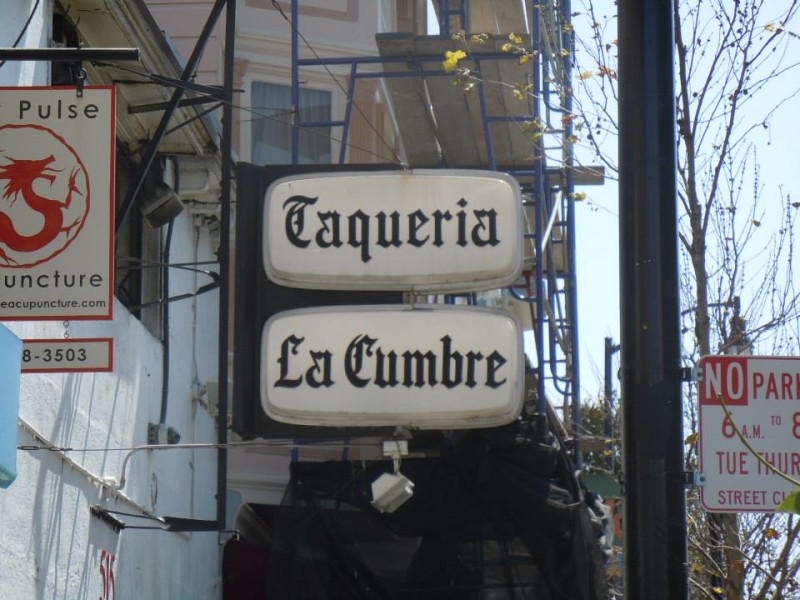
Photo Courtesy Brandon Speakman
Raul and Michaela wanted to use only the “finest and freshest ingredients” when creating their burritos, tacos, quesadillas, fajita plates and nacho creations. While choice meats and organic produce do cost a little more, Raul and Michaela say it’s worth it for the guests who choose to dine at La Cumbre. La Cumbre has since become a well-known taqueria in San Francisco and has been featured on Man v. Food, Anthony Bourdain: No Reservations, Food Paradise and Bizarre Foods: Delicious Destinations. La Cumbre is indeed a tasty “hole in the wall” Mexican restaurant to visit in San Francisco’s Mission District.

Taqueria La Cumbre Interior Photo Courtesy Wikipedia
The Cliff House
The Cliff House in San Francisco is a tasty bistro with extraordinary views, as the restaurant is built on a cliff overlooking the Pacific Ocean. The Cliff House is composed of two restaurants: The Bistro and Zinc Bar and Lounge. Both restaurants feature prime cuts of meat (14 oz. Prime Center Cut NY Steak, Grilled Dixon Lamb Chops, Spice Rubbed Barbecue Pork Spareribs) and a large selection of seafood (Roasted Alaskan Halibut, House Smoked Salmon, Fish and Chips.) The Cliff House is worth the visit for the views alone, but while you’re there, you might as well stay for a nice meal.
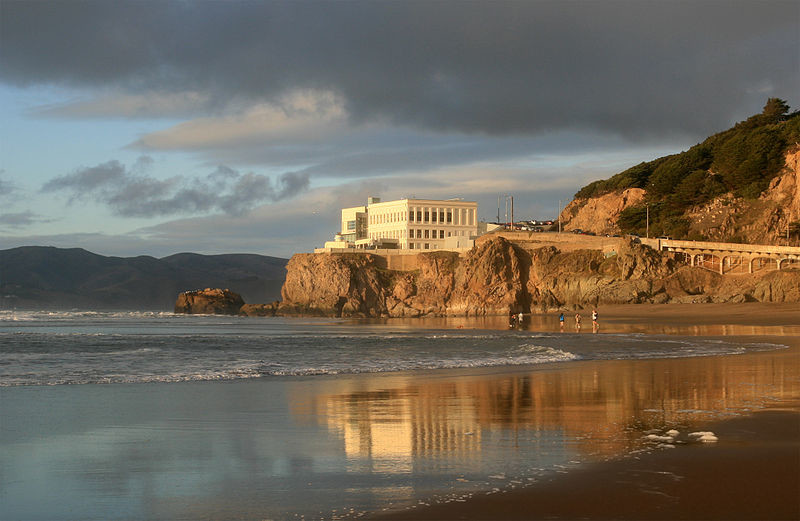
Cliff House from Ocean Beach Photo Courtesy Wikipedia
While it may be hard to find affordable housing and move to San Francisco (as it is now the most expensive city in America to live in), it will always be one of the best family vacation destinations. San Francisco will always be a city that offers beauty, great food and fun memories for your next trip. For more information about San Francisco, check out the official tourism website.

Ariel view of San Francisco from the west in April 2018. San Francisco is seen in the foreground with Oakland in the background. Photo courtesy Wikipedia








